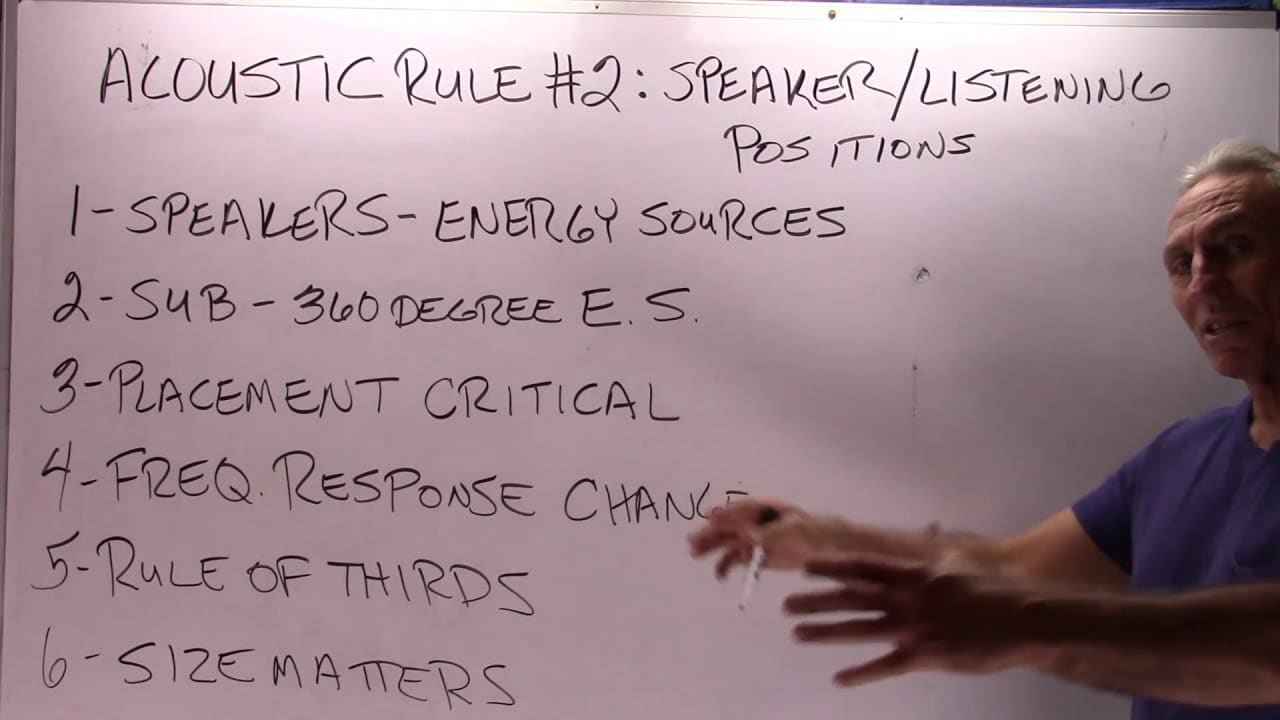Today we are going to discuss a little bit about our second acoustic rule and the series, then there are probably going to be around 10 of these, and that is the speaker listening position in the room, the power triangle, as we call it. The speaker position and the listening position in the room are critical, and you have to get that right in the beginning before you do any kind of treatment.
A lot of people like to put things where they are convenient. Well the room really doesn’t care about conveniences, the room only cares about energy. So we know our speakers are energy producing sources. Those energy producing sources sound best when they are not contained in the room. Well, unfortunately we have to live in rooms to the shields us from the environment, so we have to realize that these energy producing sources have to be positioned within the room. There is a spot in the room where they can work better than in certain other areas. We also have to remember that the sub is a huge low frequency producing energy source and you just can’t just put it where you want to. The room will tell you where it needs to go, and I’ll tell you this upfront, we are going to do a whole series on subwoofer replacement. But sitting it on the floor is one of the worst things you can do, but we will talk about that later on. The Sub is a 360 degree radiating energy source, not just out of the driver. The whole cabinet radiates energy and we are going to talk about that shortly, too, to give you an idea.
So these speakers and the listening position form this power triangle. We have to be very careful where we position this power triangle, and we have to view the whole thing as locked together. So if we move speakers up, we move speakers back, we move listening position up, we move listening position back. Let’s start with the equal triangle situation our distances between the speakers should be equal to the distance to the listening position. But this whole unit has to be considered a single unit and placed within our room size and volume. And there is a particular spot where these energy sources have a positiv impact on the frequency response in the room, regardless of treatment. So even before we address any treatment issues we want to make sure that we are not creating this low end bump in the low end. We want to make sure that it is minimized as much as possible with proper positioning out of the gate. Then our treatment comes in after that. So we want to be very careful about, where we put this where is the correct position. Well, it depends on the size of room, the volume of the room. So the size of the drivers, the energy producing sources, how large are they, what is their diameter, how many do you have. All this have to be taken in the consideration. So in line with our first rule which is “do no harm“ we want to position our speakers in a position within the room, with a certain distance form the front wall and a certain distance from the rear wall that is in balance with the room size and dimensions of the room. And there are spots that work better than others. So our goal mainly is on the low end. We can deal with the middle and high frequencies, but our main purpose is not to accentuate but attenuate this low frequency bump through proper speaker placement and listening position. And we can definitely have our frequency response impact by doing it. A popular way is the rule of thirds, where you take your room and divide it into thirds. You put your speakers in two thirds and your listening position in the other third. Good starting point in some room sizes and volumes, not in others. The smaller the room the less this becomes a more viable situation. The larger the room it get’s closer to being true. But size does matter, room size matters, speaker size matters, room volume matters, all of it has a direct impact on the frequency response of the room. So, setting your speakers and listening position up where it is convenient may not be convenient for the room.
—
This is an unedited transcript from our video series from Acoustic Fields. There will be some errors in grammar and sentence structure that occur during this translation process.
For complete understanding and comprehension, please view the video which is included in this text. For any additional information regarding this topic or others relating to room acoustics, please contact us directly at:
P: 520 – 392 – 9486







